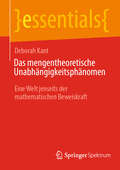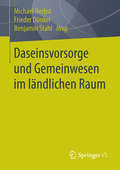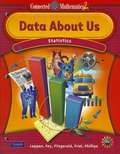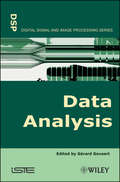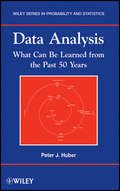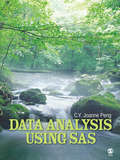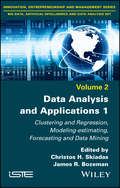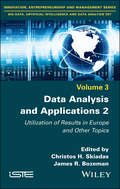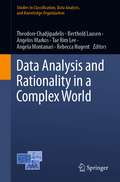- Table View
- List View
Das Zwillingsparadoxon unter Berücksichtigung der Gravitation (essentials)
by Helmut GüntherDie bewegte Uhr und eine Uhr im Gravitationsfeld gehen nach. Das berühmte Paradoxon von den Zwillingen, die sich erst voneinander entfernen und dann wieder zusammenkommen, untersuchen wir zunächst im speziell-relativistischen Gedankenexperiment, also ohne Gravitation. Der Zwilling, der seinen Bruder mit einer höheren Geschwindigkeit wieder einholt, bleibt am Ende der jüngere, was sich mit der sog. Zwillingsungleichung einfach verifizieren lässt.Die Gravitation kann prinzipiell nicht abgeschirmt werden. Ihren Einfluss auf den Gang einer Uhr verstehen wir mit einem Gedankenexperiment von V. Müller. Während die Zwillinge betragsmäßig immer dieselbe Geschwindigkeit zueinander besitzen, gelangen sie aber bei ihrer Bewegung durch den Raum in die Nähe verschiedener Massen, so dass sie unterschiedlicher Gravitation ausgesetzt sind. Das kann dazu führen, dass am Ende der zurückkehrende Zwilling sogar der ältere ist.
Das befragte Gedächtnis: Die Methodik sozialwissenschaftlicher Befragung im Lichte neurokognitiver Erkenntnisse
by Reinhard Bachleitner Martin WeichboldDas Gedächtnis und der Prozess des Erinnerns – zwei zentrale Elemente in sozialwissenschaftlichen Befragungsverfahren – sind selten thematisierte Grundlagen in der sonst breit diskutierten Befragungsmethodologie. Dieser Sammelband versucht hier Hinweise zu deren Bedeutung zu geben. Neben den grundsätzlichen Aspekten wie Einspeicherung und Abruf von Informationen, die verschiedenen endogen und exogenen Einflüssen ausgesetzt sind, werden erste empirische Studien zu einer gedächtnisbezogenen Perspektive bei Befragungen vorgestellt.
Das datengetriebene Unternehmen: Erfolgreiche Implementierung einer data-driven Organization
by Jonas RashediDaten stellen inzwischen einen unverzichtbaren Erfolgsfaktor für jedes Unternehmen dar. Der Weg zur datengetriebenen Organisation ist jedoch mit zahlreichen Herausforderungen gepflastert. Dieses Buch zeigt ein Prozessmodell für den Weg zu einem datengetriebenen Unternehmen auf und gibt Empfehlungen zur Gestaltung aller relevanten Handlungsfelder: Welche Strukturen müssen geschaffen werden? Welche Systeme und Prozesse haben sich als vorteilhaft erwiesen? Wie stellen kann die Qualität der Daten sichergestellt werden und welche Voraussetzungen benötigt die datengetriebene Organisation in den Bereichen Governance und Kommunikation? Und nicht zuletzt: Wie können die Mitarbeiter auf dem Weg mitgenommen werden und welche Implikationen hat die datengetriebene Organisation für unsere Unternehmenskultur?Jonas Rashedi zeigt einen Orientierungs- und Handlungsrahmen zur strategischen und operativen Gestaltung der datengetriebenen Organisation auf, losgelöst von aktuellen technischen Lösungen. Weitere Experten geben prägnante Lösungsvorschläge und Best Practices zu besonders relevanten Aspekten ausgewählter Handlungsfelder.
Das kleine Buch der Zahlen: Vom Abzählen bis zur Kryptographie
by Thomas Filk Peter M. HigginsSeit Jahrhunderten sind Menschen fasziniert von Zahlen. Zahlen sind jedem vertraut und bilden ein wesentliches Fundament für unser Verständnis der Welt. Und doch ist uns das Zahlensystem nicht "einfach so" gegeben, sondern es hat sich über Jahrtausende entwickelt. Trotz aller Fortschritte kann auch heute noch jedes Kind Fragen in Bezug auf Zahlen stellen, die niemand beantworten kann. Viele ungelöste Probleme im Zusammenhang mit Zahlen erscheinen wie skurrile Seltsamkeiten von geringem Nutzen, andere wiederum behindern den grundlegenden Fortschritt in wichtigen Forschungsbereichen der modernen Mathematik. Peter Higgins verarbeitet Jahrhunderte des Fortschritts zu einer erbaulichen Erzählung, die das Geheimnisvolle der Zahlen hervorhebt und erklärt, wie die verschiedenen Arten von Zahlen aufgetaucht sind und weshalb sie nützlich sind. Das Buch enthält viele historische Anmerkungen und interessante Beispiele, und es behandelt einfache Zahlenrätsel und Zaubertricks ebenso wie aufschlussreiche Verbindungen zu Problemen des Alltags: Wie bleiben beim Shoppen im Internet Einzelheiten zu unseren Bankdaten geheim? Wie groß sind die Chancen, beim Russisch Roulette zu gewinnen oder einen Flush im Poker zu erhalten? Higgins gelingt eine gut lesbare Mischung aus leichteren Inhalten und schwierigeren Ideen über das Unendliche und die komplexen Zahlen. Und für alle, die gerne eine vollständige Erklärung mögen, behandelt ein abschließendes Kapitel "Für Kenner und Genießer" nochmals spezielle Aussagen und Beispiele des Buchs in der Sprache der Mathematik. Auch heute lernen wir immer noch Neues über die Zahlen, und dieses Buch lädt uns dazu ein, die Geheimnisse und die Schönheit der Zahlen neu zu entdecken, und es erinnert uns daran, dass die Erforschung der Zahlen eine sehr lange Geschichte hat und noch haben wird.
Das mengentheoretische Unabhängigkeitsphänomen: Eine Welt jenseits der mathematischen Beweiskraft (essentials)
by Deborah KantDieses Buch erklärt kurz und prägnant die Forschung zum faszinierenden mengentheoretischen Unabhängigkeitsphänomen: Zahlreiche mengentheoretische Sätze sind gemäß den Standardaxiomen weder beweisbar noch widerlegbar. Um das zu zeigen, baut man zwei verschiedene mengentheoretische Modelle, meist mit Hilfe der bahnbrechenden Beweistechnik Forcing. Am Beispiel des berühmtesten unabhängigen Satzes – der Kontinuumshypothese – erläutert dieses Buch die Grundstruktur und die wesentlichen Argumente eines Unabhängigkeitsbeweises. Anschließend bietet es Einblicke in Themen, die Mengentheoretiker:innen aktuell beschäftigen und diskutiert verschiedene philosophische Sichtweisen auf das mysteriöse Phänomen.
Das probabilistische SIR-Modell: Projektmanagement in der Vorsorge und der Begleitung (essentials)
by Marcus HellwigBei allen Erkenntnissen, die im COVID-Prozess erfahren wurden, bleibt eine wesentliche erhalten: "Das Virus bleibt ein ständiger Begleiter". Im Gegensatz zu regelmäßig auftretenden Infektionsprozessen nimmt der einer COVID–Infektion einen andersartigen Verlauf ein. Dieser ist gekennzeichnet durch eine Dynamik, die abweichend von herkömmlichen, bekannten Prozessen dadurch abweicht, dass die Verursacher ihre Identität wechseln und entsprechende Varianten entwickeln. Daher ist ein vorsorgliches Infektionsmanagement - unterstützt durch statistisch-probabilistische Analysen mit PSIR - wichtig für eine vorsorgliches Vermeidungs-Management der Ressourcen und der Infrastruktur für die "Wellen vor der Welle".
Das Äquivalenzprinzip: Grundlagen, Tests und neueste Messungen (essentials)
by Claus Lämmerzahl Meike ListDas Äquivalenzprinzip ist grundlegend für die Allgemeine Relativitätstheorie und für unser heutiges Verständnis von Raum und Zeit. Außerdem sagen bisherige Ansätze für eine Theorie der Quantengravitation kleinste Verletzungen des Äquivalenzprinzips voraus, so dass dessen Tests auch immer eine Suche nach experimentellen Signaturen einer solchen Quantengravitationstheorie sind. Die Autoren legen in diesem Essential die begrifflichen Grundlagen des Äquivalenzprinzips anschaulich dar, geben einen Überblick über alle möglichen Testverfahren und beschreiben ausführlich den neuesten und besten Test, der auf einem Satelliten im Weltraum stattgefunden hat. Auch Vorschläge für noch bessere Tests werden diskutiert.
Daseinsvorsorge und Gemeinwesen im ländlichen Raum
by Frieder Dünkel Michael Herbst Benjamin StahlIn entlegenen, ländlichen Räumen ergeben sich komplexe Problemlagen, die eine interdisziplinäre Erforschung notwendig machen. Der vorliegende Band beleuchtet mit Hilfe unterschiedlichster Fachdisziplinen neue Ansätze für die Daseinsvorsorge und das Gemeinwesen. Beteiligt sind Sozial-/Wirtschaftsgeografie und Ökologie, Soziologie, Politikwissenschaft, Agrarwissenschaften, Gesundheitswissenschaften, Psychiatrie, Theologie, Kriminologie und Präventionswissenschaft.
Data About Us, Statistics
by Glenda Lappan James T. Fey William M. Fitzgerald Susan N. Friel Elizabeth Difanis PhillipsNIMAC-sourced textbook
Data Analysis
by Gérard GovaertThe first part of this book is devoted to methods seeking relevant dimensions of data. The variables thus obtained provide a synthetic description which often results in a graphical representation of the data. After a general presentation of the discriminating analysis, the second part is devoted to clustering methods which constitute another method, often complementary to the methods described in the first part, to synthesize and to analyze the data. The book concludes by examining the links existing between data mining and data analysis.
Data Analysis
by Peter J. HuberThis book explores the many provocative questions concerning the fundamentals of data analysis. It is based on the time-tested experience of one of the gurus of the subject matter. Why should one study data analysis? How should it be taught? What techniques work best, and for whom? How valid are the results? How much data should be tested? Which machine languages should be used, if used at all? Emphasis on apprenticeship (through hands-on case studies) and anecdotes (through real-life applications) are the tools that Peter J. Huber uses in this volume. Concern with specific statistical techniques is not of immediate value; rather, questions of strategy - when to use which technique - are employed. Central to the discussion is an understanding of the significance of massive (or robust) data sets, the implementation of languages, and the use of models. Each is sprinkled with an ample number of examples and case studies. Personal practices, various pitfalls, and existing controversies are presented when applicable. The book serves as an excellent philosophical and historical companion to any present-day text in data analysis, robust statistics, data mining, statistical learning, or computational statistics.
Data Analysis Using Hierarchical Generalized Linear Models with R
by Youngjo Lee Lars Ronnegard Maengseok NohSince their introduction, hierarchical generalized linear models (HGLMs) have proven useful in various fields by allowing random effects in regression models. Interest in the topic has grown, and various practical analytical tools have been developed. This book summarizes developments within the field and, using data examples, illustrates how to analyse various kinds of data using R. It provides a likelihood approach to advanced statistical modelling including generalized linear models with random effects, survival analysis and frailty models, multivariate HGLMs, factor and structural equation models, robust modelling of random effects, models including penalty and variable selection and hypothesis testing. This example-driven book is aimed primarily at researchers and graduate students, who wish to perform data modelling beyond the frequentist framework, and especially for those searching for a bridge between Bayesian and frequentist statistics.
Data Analysis Using Regression and Multilevel/Hierarchical Models
by Andrew GelmanData Analysis Using Regression and Multilevel/Hierarchical Models is a comprehensive manual for the applied researcher who wants to perform data analysis using linear and nonlinear regression and multilevel models. The book introduces a wide variety of models, whilst at the same time instructing the reader in how to fit these models using available software packages. The book illustrates the concepts by working through scores of real data examples that have arisen from the authors' own applied research, with programming codes provided for each one. Topics covered include causal inference, including regression, poststratification, matching, regression discontinuity, and instrumental variables, as well as multilevel logistic regression and missing-data imputation. Practical tips regarding building, fitting, and understanding are provided throughout.
Data Analysis Using SAS
by Dr Chao-Ying Joanne PengData Analysis Using SAS offers a comprehensive core text focused on key concepts and techniques in quantitative data analysis using the most current SAS commands and programming language. The coverage of the text is more evenly balanced among statistical analysis, SAS programming, and data/file management than any available text on the market. It provides students with a hands-on, exercise-heavy method for learning basic to intermediate SAS commands while understanding how to apply statistics and reasoning to real-world problems. Designed to be used in order of teaching preference by instructor, the book is comprised of two primary sections: the first half of the text instructs students in techniques for data and file managements such as concatenating and merging files, conditional or repetitive processing of variables, and observations. The second half of the text goes into great depth on the most common statistical techniques and concepts - descriptive statistics, correlation, analysis of variance, and regression - used to analyze data in the social, behavioral, and health sciences using SAS commands. A student study at www.sagepub.com/pengstudy comes replete with a multitude of computer programs, their output, specific details on how to check assumptions, as well as all data sets used in the book. Data Analysis Using SAS is a complete resource for Data Analysis I and II, Statistics I and II, Quantitative Reasoning, and SAS Programming courses across the social and behavioral sciences and health - especially those that carry a lab component.
Data Analysis Using SAS Enterprise Guide
by Lawrence S. Meyers Glenn Gamst A. J. GuarinoThis book presents the basic procedures for utilizing SAS Enterprise Guide to analyze statistical data. SAS Enterprise Guide is a graphical user interface (point and click) to the main SAS application. Each chapter contains a brief conceptual overview and then guides the reader through concrete step-by-step examples to complete the analyses. The eleven sections of the book cover a wide range of statistical procedures including descriptive statistics, correlation and simple regression, t tests, one-way chi square, data transformations, multiple regression, analysis of variance, analysis of covariance, multivariate analysis of variance, factor analysis, and canonical correlation analysis. Designed to be used either as a stand-alone resource or as an accompaniment to a statistics course, the book offers a smooth path to statistical analysis with SAS Enterprise Guide for advanced undergraduate and beginning graduate students, as well as professionals in psychology, education, business, health, social work, sociology, and many other fields.
Data Analysis Using SAS Enterprise Guide
by Lawrence S. Meyers Glenn Gamst A. J. Guarino Lawrence S. Meyers Glenn GamstThis book presents the basic procedures for utilizing SAS Enterprise Guide to analyze statistical data. SAS Enterprise Guide is a graphical user interface (point and click) to the main SAS application. Each chapter contains a brief conceptual overview and then guides the reader through concrete step-by-step examples to complete the analyses. The eleven sections of the book cover a wide range of statistical procedures including descriptive statistics, correlation and simple regression, t tests, one-way chi square, data transformations, multiple regression, analysis of variance, analysis of covariance, multivariate analysis of variance, factor analysis, and canonical correlation analysis. Designed to be used either as a stand-alone resource or as an accompaniment to a statistics course, the book offers a smooth path to statistical analysis with SAS Enterprise Guide for advanced undergraduate and beginning graduate students, as well as professionals in psychology, education, business, health, social work, sociology, and many other fields.
Data Analysis and Applications 1: New and Classical Approaches
by Christos H. Skiadas James R. BozemanThis series of books collects a diverse array of work that provides the reader with theoretical and applied information on data analysis methods, models, and techniques, along with appropriate applications.Volume 1 begins with an introductory chapter by Gilbert Saporta, a leading expert in the field, who summarizes the developments in data analysis over the last 50 years. The book is then divided into three parts: Part 1 presents clustering and regression cases; Part 2 examines grouping and decomposition, GARCH and threshold models, structural equations, and SME modeling; and Part 3 presents symbolic data analysis, time series and multiple choice models, modeling in demography, and data mining.
Data Analysis and Applications 2: Utilization of Results in Europe and Other Topics
by Christos H. Skiadas James R. BozemanThis series of books collects a diverse array of work that provides the reader with theoretical and applied information on data analysis methods, models and techniques, along with appropriate applications.Volume 2 begins with an introductory chapter by Gilbert Saporta, a leading expert in the field, who summarizes the developments in data analysis over the last 50 years. The book is then divided into four parts: Part 1 examines (in)dependence relationships, innovation in the Nordic countries, dentistry journals, dependence among growth rates of GDP of V4 countries, emissions mitigation, and five-star ratings; Part 2 investigates access to credit for SMEs, gender-based impacts given Southern Europe’s economic crisis, and labor market transition probabilities; Part 3 looks at recruitment at university job-placement offices and the Program for International Student Assessment; and Part 4 examines discriminants, PageRank, and the political spectrum of Germany.
Data Analysis and Applications 4: Financial Data Analysis and Methods
by Alex Karagrigoriou Christos H. Skiadas Andreas MakridesData analysis as an area of importance has grown exponentially, especially during the past couple of decades. This can be attributed to a rapidly growing computer industry and the wide applicability of computational techniques, in conjunction with new advances of analytic tools. This being the case, the need for literature that addresses this is self-evident. New publications are appearing, covering the need for information from all fields of science and engineering, thanks to the universal relevance of data analysis and statistics packages. This book is a collective work by a number of leading scientists, analysts, engineers, mathematicians and statisticians who have been working at the forefront of data analysis. The chapters included in this volume represent a cross-section of current concerns and research interests in these scientific areas. The material is divided into three parts: Financial Data Analysis and Methods, Statistics and Stochastic Data Analysis and Methods, and Demographic Methods and Data Analysis- providing the reader with both theoretical and applied information on data analysis methods, models and techniques and appropriate applications.
Data Analysis and Approximate Models: Model Choice, Location-Scale, Analysis of Variance, Nonparametric Regression and Image Analysis (Chapman & Hall/CRC Monographs on Statistics and Applied Probability)
by Patrick Laurie DaviesThe First Detailed Account of Statistical Analysis That Treats Models as ApproximationsThe idea of truth plays a role in both Bayesian and frequentist statistics. The Bayesian concept of coherence is based on the fact that two different models or parameter values cannot both be true. Frequentist statistics is formulated as the problem of estimating
Data Analysis and Classification: Methods and Applications (Studies in Classification, Data Analysis, and Knowledge Organization)
by Krzysztof Jajuga Marek Walesiak Krzysztof NajmanThis volume gathers peer-reviewed contributions that address a wide range of recent developments in the methodology and applications of data analysis and classification tools in micro and macroeconomic problems. The papers were originally presented at the 29th Conference of the Section on Classification and Data Analysis of the Polish Statistical Association, SKAD 2020, held in Sopot, Poland, September 7–9, 2020. Providing a balance between methodological contributions and empirical papers, the book is divided into five parts focusing on methodology, finance, economics, social issues and applications dealing with COVID-19 data. It is aimed at a wide audience, including researchers at universities and research institutions, graduate and doctoral students, practitioners, data scientists and employees in public statistical institutions.
Data Analysis and Classification: Proceedings of the 6th Conference of the Classification and Data Analysis Group of the Società Italiana di Statistica (Studies in Classification, Data Analysis, and Knowledge Organization)
by Carlo Natale Lauro Michael Greenacre Francesco PalumboThe volume provides results from the latest methodological developments in data analysis and classification and highlights new emerging subjects within the field. It contains articles about statistical models, classification, cluster analysis, multidimensional scaling, multivariate analysis, latent variables, knowledge extraction from temporal data, financial and economic applications, and missing values. Papers cover both theoretical and empirical aspects.
Data Analysis and Graphics Using R - an Example-Based Approach
by John Maindonald W. John BraunDiscover what you can do with R! Introducing the R system, covering standard regression methods, then tackling more advanced topics, this book guides users through the practical, powerful tools that the R system provides. The emphasis is on hands-on analysis, graphical display, and interpretation of data. The many worked examples, from real-world research, are accompanied by commentary on what is done and why. The companion website has code and datasets, allowing readers to reproduce all analyses, along with solutions to selected exercises and updates. Assuming basic statistical knowledge and some experience with data analysis (but not R), the book is ideal for research scientists, final-year undergraduate or graduate-level students of applied statistics, and practising statisticians. It is both for learning and for reference. This third edition expands upon topics such as Bayesian inference for regression, errors in variables, generalized linear mixed models, and random forests.
Data Analysis and Optimization: In Honor of Boris Mirkin's 80th Birthday (Springer Optimization and Its Applications #202)
by Boris Goldengorin Sergei KuznetsovThis book presents the state-of-the-art in the emerging field of data science and includes models for layered security with applications in the protection of sites—such as large gathering places—through high-stake decision-making tasks. Such tasks include cancer diagnostics, self-driving cars, and others where wrong decisions can possibly have catastrophic consequences. Additionally, this book provides readers with automated methods to analyze patterns and models for various types of data, with applications ranging from scientific discovery to business intelligence and analytics. The book primarily includes exploratory data analysis, pattern mining, clustering, and classification supported by real life case studies. The statistical section of this book explores the impact of data mining and modeling on the predictability assessment of time series. Further new notions of mean values based on ideas of multi-criteria optimization are compared with their conventional definitions, leading to new algorithmic approaches to the calculation of the suggested new means. The style of the written chapters and the provision of a broad yet in-depth overview of data mining, integrating novel concepts from machine learning and statistics, make the book accessible to upper level undergraduate and graduate students in data mining courses. Students and professionals specializing in computer and management science, data mining for high-dimensional data, complex graphs and networks will benefit from the cutting-edge ideas and practically motivated case studies in this book.
Data Analysis and Rationality in a Complex World (Studies in Classification, Data Analysis, and Knowledge Organization)
by Angela Montanari Berthold Lausen Theodore Chadjipadelis Angelos Markos Tae Rim Lee Rebecca NugentThis volume presents the latest advances in statistics and data science, including theoretical, methodological and computational developments and practical applications related to classification and clustering, data gathering, exploratory and multivariate data analysis, statistical modeling, and knowledge discovery and seeking. It includes contributions on analyzing and interpreting large, complex and aggregated datasets, and highlights numerous applications in economics, finance, computer science, political science and education. It gathers a selection of peer-reviewed contributions presented at the 16th Conference of the International Federation of Classification Societies (IFCS 2019), which was organized by the Greek Society of Data Analysis and held in Thessaloniki, Greece, on August 26-29, 2019.




